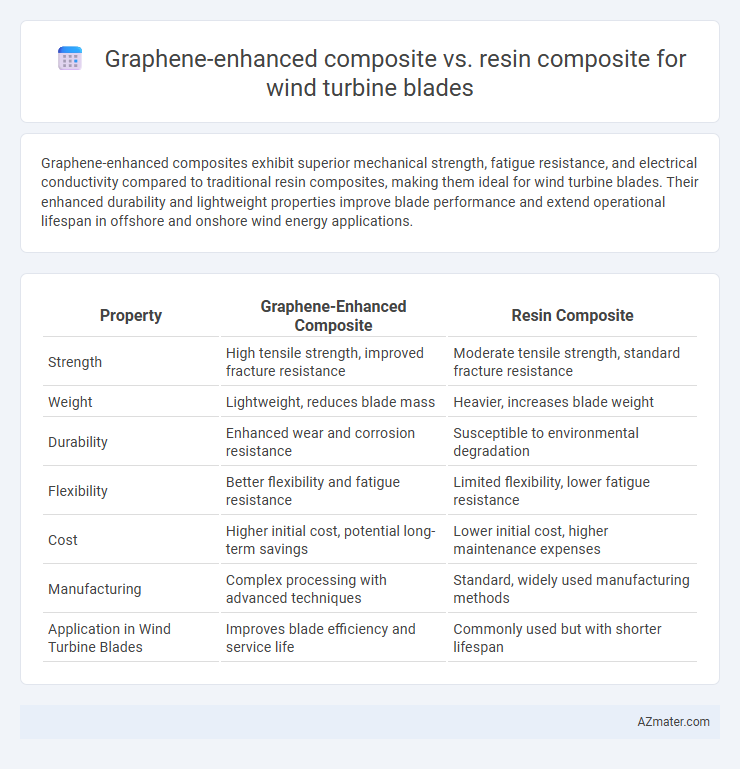Graphene-enhanced composites exhibit superior mechanical strength, fatigue resistance, and electrical conductivity compared to traditional resin composites, making them ideal for wind turbine blades. Their enhanced durability and lightweight properties improve blade performance and extend operational lifespan in offshore and onshore wind energy applications.
Table of Comparison
| Property | Graphene-Enhanced Composite | Resin Composite |
|---|---|---|
| Strength | High tensile strength, improved fracture resistance | Moderate tensile strength, standard fracture resistance |
| Weight | Lightweight, reduces blade mass | Heavier, increases blade weight |
| Durability | Enhanced wear and corrosion resistance | Susceptible to environmental degradation |
| Flexibility | Better flexibility and fatigue resistance | Limited flexibility, lower fatigue resistance |
| Cost | Higher initial cost, potential long-term savings | Lower initial cost, higher maintenance expenses |
| Manufacturing | Complex processing with advanced techniques | Standard, widely used manufacturing methods |
| Application in Wind Turbine Blades | Improves blade efficiency and service life | Commonly used but with shorter lifespan |
Introduction to Wind Turbine Blade Materials
Wind turbine blade materials demand high strength-to-weight ratios and excellent fatigue resistance, positioning advanced composites as critical for performance and durability. Graphene-enhanced composites provide superior mechanical properties, such as increased tensile strength and enhanced impact resistance, compared to traditional resin composites commonly used in blade manufacturing. Integrating graphene into resin matrices significantly improves stiffness and structural integrity, enabling longer blade lifespans and improved energy efficiency in wind turbine operations.
Overview of Resin Composites in Wind Turbines
Resin composites dominate wind turbine blade manufacturing due to their excellent strength-to-weight ratio, corrosion resistance, and cost-effectiveness. These materials combine polymer resins with reinforcing fibers like glass or carbon fiber, providing durability and fatigue resistance essential for large-scale wind applications. Enhancing resin composites with graphene can further improve mechanical properties, thermal stability, and electrical conductivity, leading to longer blade lifespans and improved performance under dynamic wind conditions.
Advancements in Graphene-Enhanced Composites
Graphene-enhanced composites exhibit superior mechanical strength, increased fatigue resistance, and enhanced electrical conductivity compared to traditional resin composites, making them ideal for wind turbine blade applications. Innovations in graphene integration improve the composite's stiffness-to-weight ratio and durability, allowing for longer blade lifespans and reduced maintenance costs. These advancements facilitate the production of larger, more efficient wind turbine blades capable of withstanding harsh environmental conditions and extreme loading.
Mechanical Strength Comparison
Graphene-enhanced composites exhibit significantly higher mechanical strength than traditional resin composites used in wind turbine blades, offering superior tensile and flexural strength. The incorporation of graphene nanosheets improves the load-bearing capacity and fatigue resistance due to its exceptional stiffness and fracture toughness. This results in enhanced durability and longer service life of wind turbine blades under extreme operational stress.
Durability and Fatigue Resistance
Graphene-enhanced composites exhibit superior durability and fatigue resistance compared to traditional resin composites in wind turbine blades, due to graphene's exceptional mechanical strength and ability to impede crack propagation. The incorporation of graphene enhances load distribution and energy dissipation under cyclic stresses, significantly extending the blade's operational lifespan. This improvement in fatigue resistance reduces maintenance costs and enhances reliability in harsh environmental conditions.
Weight Reduction and Structural Efficiency
Graphene-enhanced composites exhibit significantly higher tensile strength and stiffness compared to traditional resin composites, enabling substantial weight reduction in wind turbine blades without compromising structural integrity. The exceptional thermal conductivity and fracture toughness of graphene-infused materials improve fatigue resistance and durability under extreme operational conditions. Integrating graphene into composite matrices enhances blade lifespan and efficiency, reducing maintenance costs while maximizing energy output through optimized aerodynamic performance.
Cost-Benefit Analysis
Graphene-enhanced composites offer superior mechanical strength and fatigue resistance compared to traditional resin composites, leading to longer lifespan and reduced maintenance costs for wind turbine blades. Despite higher initial material costs, the improved durability and energy efficiency translate into significant long-term savings and higher return on investment. Cost-benefit analysis reveals that graphene composites provide enhanced performance value, especially in large-scale, high-stress wind turbine applications.
Environmental Impact and Sustainability
Graphene-enhanced composites for wind turbine blades offer superior durability and corrosion resistance compared to traditional resin composites, significantly extending blade lifespan and reducing material waste. The lightweight nature of graphene composites contributes to lower energy consumption during manufacturing and transportation, enhancing overall sustainability. These materials also enable more efficient recycling processes, minimizing environmental impact throughout the blade's lifecycle.
Future Prospects and Industry Trends
Graphene-enhanced composites offer superior mechanical strength, lightweight characteristics, and improved fatigue resistance compared to resin composites, making them ideal for next-generation wind turbine blades aimed at higher efficiency and durability. Industry trends indicate increasing integration of graphene composites driven by falling production costs and advancements in scalable manufacturing techniques. Future prospects emphasize sustainable materials and enhanced performance, positioning graphene-enhanced composites as a crucial innovation for longer-lasting, more efficient wind energy systems.
Conclusion: Choosing the Optimal Composite
Graphene-enhanced composites offer superior mechanical strength, enhanced fatigue resistance, and improved thermal conductivity compared to traditional resin composites, making them ideal for wind turbine blades subjected to extreme environmental stresses. Their lightweight nature and higher durability contribute to longer blade lifespan and reduced maintenance costs, which is critical for optimizing energy production efficiency. Selecting graphene-enhanced composites ensures better structural integrity and overall performance, despite potentially higher initial material costs.

Infographic: Graphene-enhanced composite vs Resin composite for Wind turbine blade
 azmater.com
azmater.com